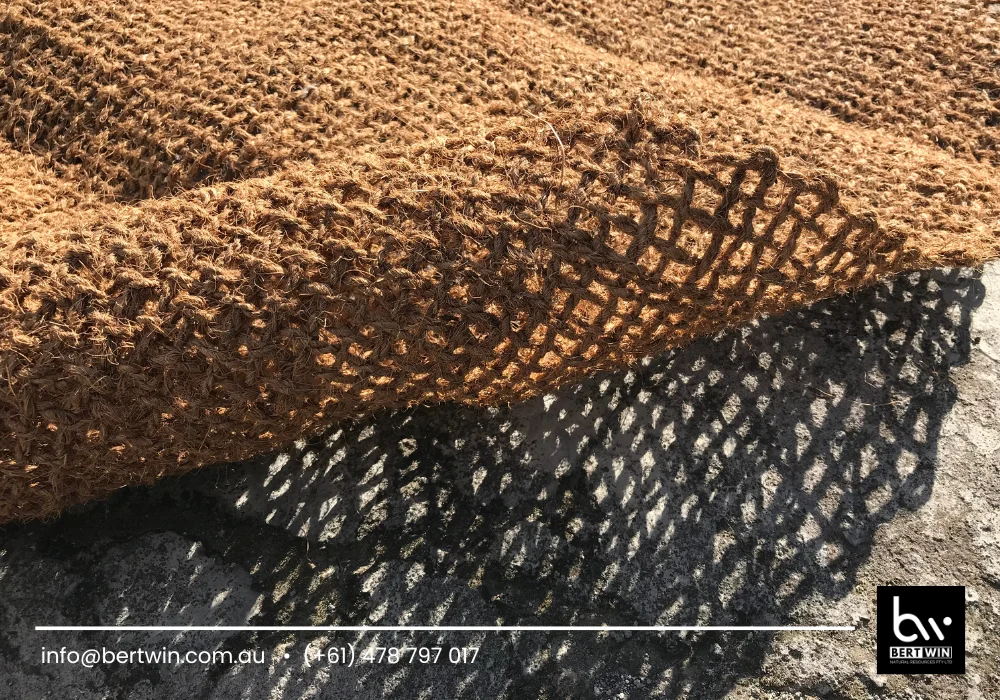Introduction to Coco Mesh for Mining Site Rehabilitation
In the field of environmental restoration, Coco Mesh for mining site rehabilitation is proving to be a reliable and eco-friendly solution. This biodegradable product, derived from the husk of coconuts, helps stabilize soil, prevent erosion, and support revegetation efforts on disturbed mining lands. As industries prioritize sustainability and environmental responsibility, coco mesh has emerged as a preferred option in rehabilitation projects worldwide.

What Is Coco Mesh?
Coco mesh, also known as coir netting, is made from twisted coir fiber extracted from coconut husks. It is woven into strong, yet biodegradable nets available in various thicknesses and densities. The natural structure of the mesh provides an ideal surface for plants to anchor their roots while holding soil particles in place.
Why Use Coco Mesh in Mining Rehabilitation?
1. Soil Stabilization and Erosion Control
Mining activities often leave behind barren and unstable soil surfaces that are highly vulnerable to erosion. Coco Mesh for mining site rehabilitation is an effective method to stabilize these areas. The mesh anchors the topsoil, significantly reducing the risk of landslides and sediment runoff, especially during heavy rainfall.
2. Promotes Natural Regrowth
Coco mesh creates an ideal micro-environment for seeds to germinate and plants to grow. By covering degraded land with coir netting, moisture retention improves, sunlight exposure is moderated, and seedlings are protected from wind and water erosion. Over time, the vegetation establishes itself naturally.
3. Biodegradable and Sustainable
Unlike synthetic materials, coco mesh breaks down over time, enriching the soil with organic matter as it decomposes. Its environmental footprint is minimal, making it a suitable choice for long-term rehabilitation without the need for post-installation removal.
Application Areas in Mining
Coco mesh can be applied across various parts of a mining site, including:
- Slopes and embankments
- Tailings dams
- Access roads
- Drainage channels
- Spoil piles
Each of these areas benefits from the structural integrity and natural support offered by coco mesh.
Installation Tips

Installing Coco Mesh for mining site rehabilitation involves:
- Clearing and leveling the targeted area.
- Rolling out the coco mesh and securing it with wooden or biodegradable pegs.
- Seeding the area underneath or through the mesh if vegetation has not already been established.
- Watering the area to encourage seed germination and plant growth.
This straightforward process can lead to significant long-term restoration benefits.
Long-Term Environmental Impact
By encouraging vegetation growth and minimizing erosion, coco mesh helps accelerate the natural rehabilitation process. It restores the land’s ability to support native flora and fauna, improving overall biodiversity. Additionally, it supports regulatory compliance for mining companies seeking to meet environmental standards and avoid penalties.
Advantages Over Synthetic Alternatives
- Natural Decomposition: Coco mesh leaves behind no microplastics or synthetic residue.
- Cost Efficiency: Requires no removal after its functional period.
- Aesthetic Integration: Blends naturally into the landscape, unlike artificial materials.
- Renewable Resource: Coir is harvested from coconuts, a widely available and renewable resource.
Final Thoughts
Using Coco Mesh for mining site rehabilitation offers a practical, environmentally responsible solution for post-mining recovery. It supports soil integrity, enables vegetation regrowth, and aligns with sustainable land management practices. As industries move toward greener alternatives, coco mesh stands out as a vital component of ecological restoration strategies.
For further information, you may contact WhatsApp at (+61) 478797017 or via email at info@bertwin.com.au.
